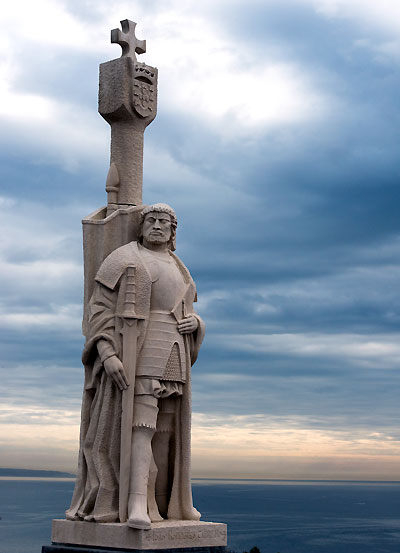National Register of Historic Places in San Diego County
Cabrillo National Monument
Point Loma
San Diego
Created 1913
Captain Juan Rodriguez Cabrillo, in the service of the King of Spain, sailed north from Mexico in June of 1542. The flagship San Salvador and the frigate Victoria entered a hitherto unknown port on September 28. They were the first Europeans to enter San Diego Bay.
Cabrillo National Monument was created on October 14, 1913, when President Woodrow Wilson reserved a half acre of Fort Rosecrans. The plan was to demolish the Old Point Loma Lighthouse and erect a 150-foot-tall monument to Cabrillo.
By 1926, no statue had been erected. President Coolidge authorized the Native Sons of the Golden West to erect a suitable monument, but they were also unable to carry out the commission.
In 1939, the Portuguese government commissioned sculptor Alvaro de Bree to create a heroic statue of Cabrillo for the Golden Gate International Exposition in San Francisco. When the statue arrived too late, it was places in storage.
In 1940, the statue was shipped it to San Diego where it was once again placed in storage at the Naval Training Center San Diego. Finally, in 1949, it was installed near the Old Point Loma Lighthouse. In 1965, the National Park Service moved the statue to a dramatic overlook near the newly completed visitor center.
The statue, carved from a porous, stratified limestone and broken in places, suffered from the marine air. In the 1980s, the Portuguese sculptor Joas Chartes Almeida carved an exact duplicate of the original statue from harder stone. The new statue was installed at the overlook in February 1988, and the original statue was placed back in storage.

The U.S. Army administered the monument until 1933 when it turned it over to the Department of the Interior to become part of the national park system.
Starting in World War I and lasting through World War II, the monument area was an integral part of the harbor defenses of San Diego. Gun batteries, coastal searchlight batteries, artillery fire control stations, a radio station, and a signal station (the Old Point Loma Lighthouse) played key roles in the defenses. At one point, the guns of Battery Point Loma were San Diego's only defensive weapons against a potential enemy approaching from the west or northwest. Many of the elements continued in active service until the harbor defenses of San Diego were formally discontinued on January 1, 1950.
Most of the historic resources within the Cabrillo National Monument are related to the role of Point Loma in the harbor defenses of San Diego: bunkers, batteries and other structures. The Old Point Loma Lighthouse predates the military's presence, though it too was used during World Wars I and II.
Although the original statue of Cabrillo is of prime importance to the park for its purpose in commemorating the voyage of Cabrillo and as part of the 1934 landscape design of the park, it is considered non-contributing because it has been moved from its original site.
Cabrillo Monument was off-limits to the public during World War II because the entire south end of the Point Loma Peninsula was reserved for military purposes. Following the war, the area of the national monument was enlarged significantly by Presidents Eisenhower and Ford to more than 140 acres.
Source: Adapted from the NRHP nomination submitted in 1997 and from Wikipedia.

Cabrillo National Monument was placed on the National Register of Historic Places in 1966 without a formal nomination. A formal NRHP nomination was prepared by the National Park Service in 1997 and approved in 1998.
